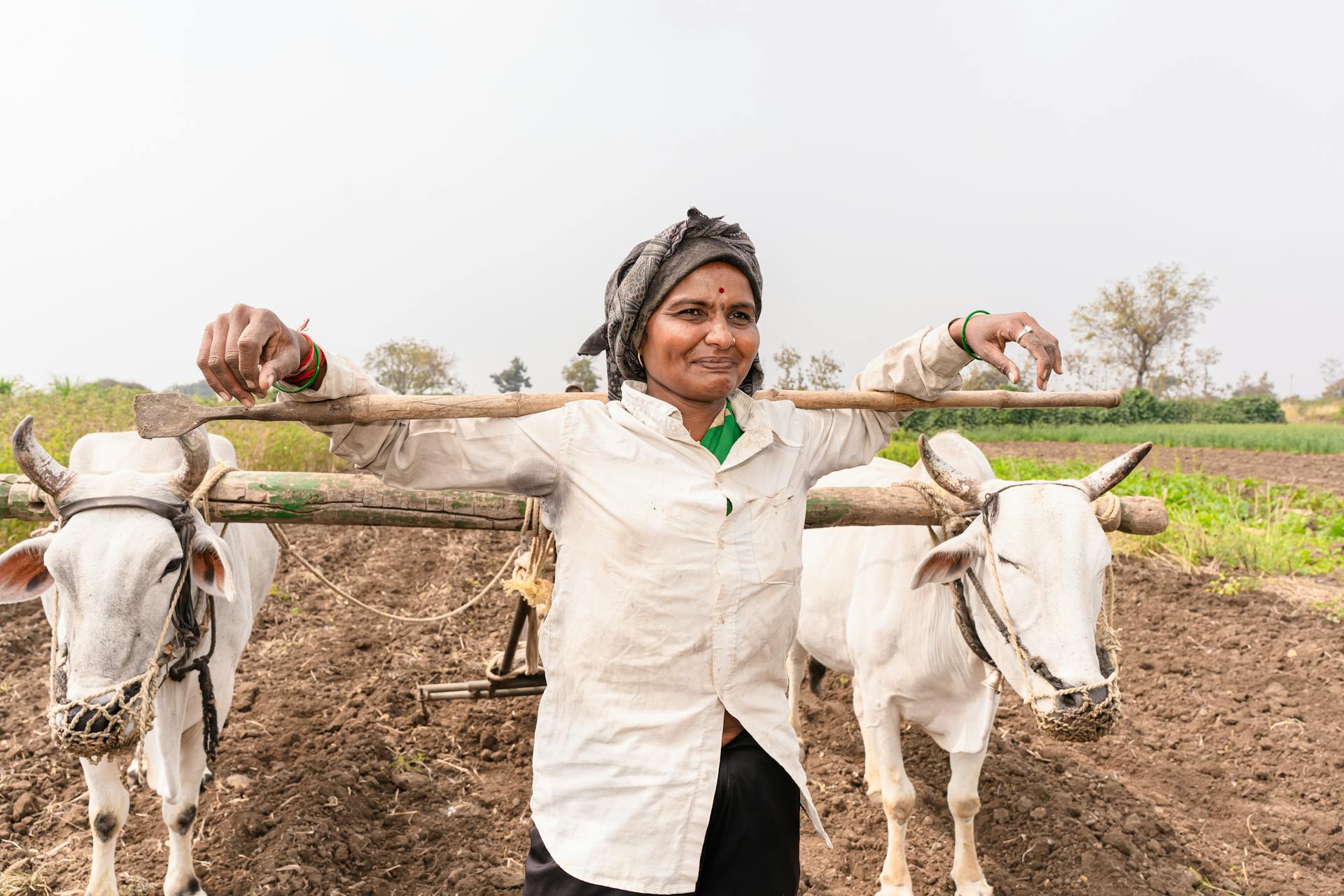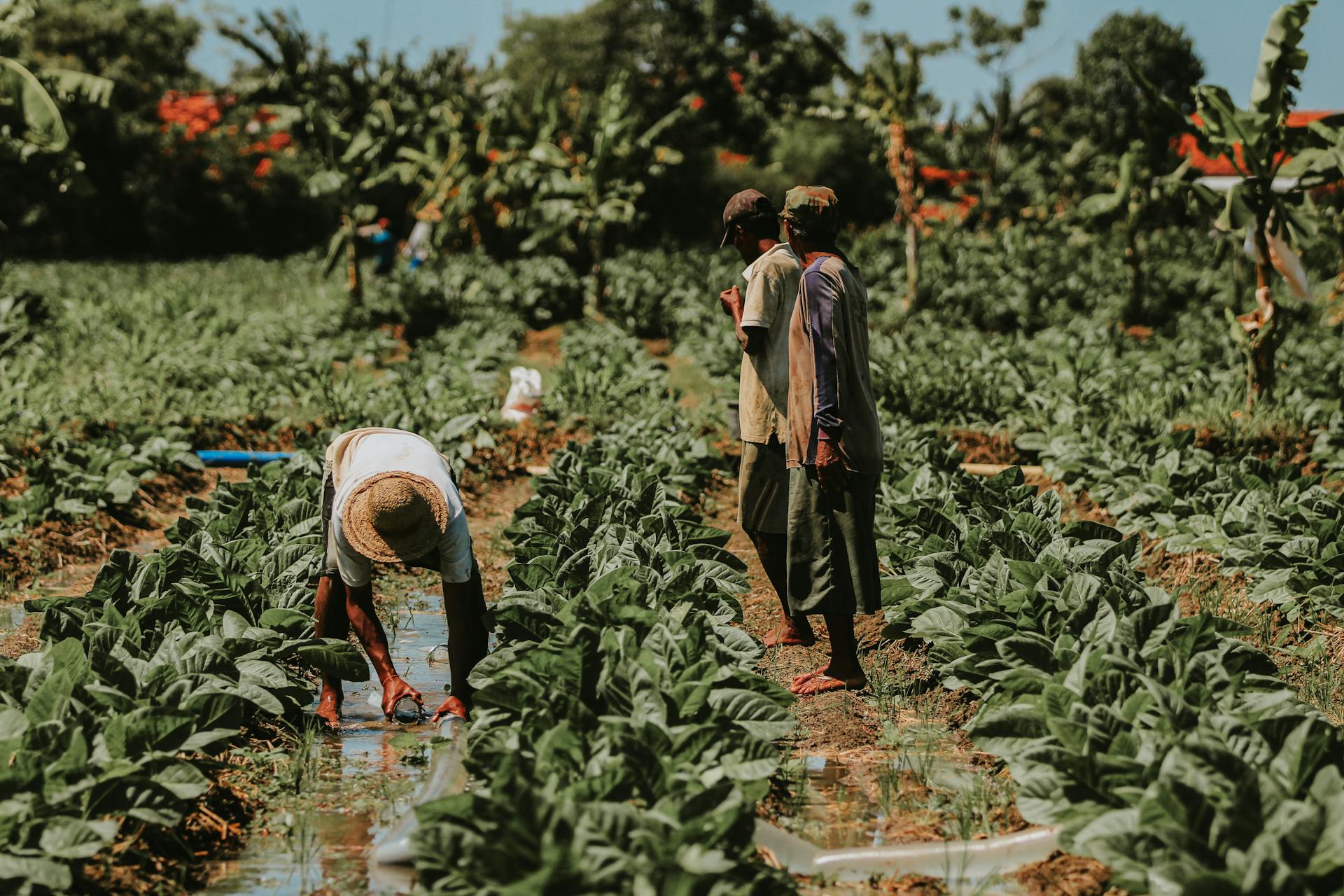
The agricultural revolution is a term used to describe the massive change in the way that crops were grown and animals were domesticated that took place in the span of a few short centuries. This revolution allowed for the growth of civilization as we know it, and it is responsible for the food security that many of us take for granted. There are three primary characteristics of the agricultural revolution that are worth discussing.
The first characteristic is the transition from hunting and gathering to the systematic cultivation of crops. This transition began around 10,000 BC in the Fertile Crescent, and it allowed for a more reliable food supply. It also allowed for the domestication of plants and animals, which led to the second characteristic: the growth of settlements. With a more reliable food supply, people were able to stay in one place for longer periods of time. This led to the growth of cities and the rise of civilizations.
The third characteristic of the agricultural revolution is the development of new technologies. This includes the invention of the plow, which allowed for the cultivation of larger areas of land. It also includes the development of irrigation systems, which made it possible to grow crops in areas that otherwise would have been too dry. The agricultural revolution was a complex process that had a profound impact on the world. It is responsible for the food security that we enjoy today, and it laid the foundation for the growth of civilization.
A fresh viewpoint: Haitian Revolution
What were the consequences of the agricultural revolution?
The agricultural revolution was a time of change in the way that food was grown and harvested. It had a profound impact on the way that people lived and worked, and the way that they thought about the world around them.
The agricultural revolution began in the Middle East, where people first began to cultivate crops and domesticate animals. From there, it spread to Europe and Asia, and eventually to the Americas. The changes that it brought were far-reaching and long-lasting.
One of the most significant changes was the way that people lived. Prior to the agricultural revolution, most people were hunter-gatherers. They moved from place to place in search of food. But with the advent of agriculture, people began to settle down in one place. They built homes and villages, and created communities.
The agricultural revolution also changed the way that people worked. Hunter-gatherers had to spend a lot of time searching for food. But with agriculture, people could grow their own food. This meant that they had more time for other activities, such as making art, writing, and invented.
The agricultural revolution also had an impact on the way that people thought about the world. Prior to the agricultural revolution, people believed that the world was a scary place. They thought that there were monsters and spirits that could harm them. But with the advent of agriculture, people began to see the world in a different light. They saw it as a place where they could live in peace and security. They began to believe in their own ability to shape their own destiny.
The agricultural revolution was a time of great change. It transformed the way that people lived and worked, and the way that they thought about the world around them.
On a similar theme: Food Contact Surfaces
How did the agricultural revolution change the way we farm?
The agricultural revolution was a time of great change for the way we farm. It saw the introduction of new technologies and methods that greatly increased the productivity of agriculture. This in turn allowed for a population explosion as more people could be supported by the increased food production.
The most significant change during the agricultural revolution was the switch from manual labor to machine labor. This was made possible by the invention of new machines such as the tractor and combine harvester. These machines greatly increased the efficiency of farming, and allowed farmers to cover more ground in less time.
The introduction of new crop varieties was also crucial during the agricultural revolution. These new varieties were often more disease-resistant and produced higher yields than the traditional varieties. This helped to further increase the food supply, and ensured that there was enough to go around.
Overall, the agricultural revolution changed the way we farm in a number of ways. It introduced new technologies and methods that greatly increased the productivity of agriculture. This in turn allowed for a population explosion as more people could be supported by the increased food production.
For your interest: Clean Revolution Fabric
What crops were grown during the agricultural revolution?
The Agricultural Revolution was a time period in which new farming techniques and technologies were developed. This period saw a huge increase in agricultural productivity, which led to a decrease in prices and an increase in the availability of food. One of the most important aspects of the Agricultural Revolution was the introduction of new crops. These crops were better suited to the changing climate and soil conditions, and they were more productive than the traditional crops that were grown during this time. Some of the new crops that were introduced include wheat, barley, oats, rye, peas, and lentils. These crops allowed for a more diversified diet and helped to improve the nutrition of those who lived during this time.
The Agricultural Revolution was a crucial time in human history, and it had a profound impact on the development of civilization. The introduction of new crops played a major role in this period, and they helped to transform the way that people lived and worked. The Agricultural Revolution was a time of great progress, and it helped to lay the foundation for the modern world.
On a similar theme: Agricultural Research Council
How did the agricultural revolution impact the way we eat?
The agricultural revolution is a term used to describe the radical change in the way humans began to farm and domesticate plants and animals for food. This change began around 10,000 years ago, and led to the development of civilizations and the rise of cities. Prior to the agricultural revolution, humans were hunter-gatherers who relied on wild foods for their survival. The agricultural revolution allowed humans to settle in one place, which led to the development of civilizations. The impact of the agricultural revolution on the way we eat is significant.
The agricultural revolution led to the domestication of plants and animals, which allowed humans to develop agriculture. Agriculture allowed humans to grow their own food, which meant that they no longer had to rely on hunting and gathering for their survival. This led to the development of civilizations, as well as the rise of cities. The impact of the agricultural revolution on the way we eat is significant. Agriculture allowed humans to grow their own food, which led to the development of civilizations. Agriculture also allowed humans to domesticate plants and animals, which led to the domestication of plants and animals. This led to the development of food production, which has had a significant impact on the way we eat.
Food production allowed humans to control their food supply, which led to the development of a food surplus. The food surplus allowed humans to trade for other goods and services, which led to the development of the economy. The food surplus also allowed humans to feed larger populations, which led to the development of cities. The impact of the agricultural revolution on the way we eat is significant. The agricultural revolution led to the development of food production, which has had a significant impact on the way we eat.
You might like: Dutch Agriculture Critically Dependent
What was the role of animals in the agricultural revolution?
One of the most important aspects of the agricultural revolution was the domestication of plants and animals. This allowed for the growth of crops and the raising of livestock on a scale that was not possible before. Animals played a vital role in this process, as they were used to plow fields, transport goods, and provide manure for crops. Without the help of these animals, the agricultural revolution would not have been possible.
If this caught your attention, see: Feminist Revolution
How did the agricultural revolution affect the environment?
The Agricultural Revolution was a period of rapid technological change in agriculture that occurred between the 18th and early 19th centuries. It was a major factor in the expansion of the British Empire and the Industrial Revolution. The Agricultural Revolution began in Europe, but it quickly spread to other parts of the world, including the United States and Russia.
The Agricultural Revolution led to a dramatic increase in food production, which in turn led to a population explosion. The world's population more than doubled between 1700 and 1900, from 700 million to 1.6 billion. At the same time, the amount of land under cultivation increased by a factor of four. This increase in food production was made possible by a number of new technologies, including better seeds, more productive livestock, and new farming methods.
The Agricultural Revolution had a profound impact on the environment. The most obvious change was the clearing of forests to make way for farmland. This had a number of impacts, including the loss of habitat for many animals and the release of large amounts of carbon dioxide into the atmosphere. farmland also tends to be more vulnerable to erosion than forestland, so the Agricultural Revolution led to an increase in soil erosion.
The Agricultural Revolution also led to an increase in water use. In the past, most farms were rain-fed, but the new technologies of the Agricultural Revolution allowed farms to be irrigated. This led to the depletion of aquifers and the development of water shortages in some areas.
The Agricultural Revolution had a number of positive effects on the environment as well. The increased food production made possible by the new technologies allowed more people to survive and thrive. This in turn led to the development of cities and the growth of civilizations. The Agricultural Revolution also led to an increase in the diversity of crops grown around the world. This increased the world's food security and made it less likely that any one crop would be wiped out by a disease.
In conclusion, the Agricultural Revolution had a profound impact on the environment, both positive and negative. The increase in food production made possible by the new technologies led to a population explosion and the development of cities. At the same time, the clearing of forests and the increase in water use had a number of negative impacts on the environment.
A different take: Development Led
What was life like before the agricultural revolution?
The agricultural revolution was a time when humans began to farm for their food. This was a huge turning point in human history as it allowed for the growth of civilizations. Prior to the agricultural revolution, humans were hunter-gatherers. This means that they would travel in search of food and resources. They would also make use of the resources they found, such as hunting animals for food and gathering fruits and vegetables. The agricultural revolution changed all of this as it allowed humans to settle down in one place and farm for their food. This led to the growth of cities and civilizations. It also allowed for the development of new technologies and the growth of knowledge. The agricultural revolution was a time of great change for humanity and it is responsible for the world we live in today.
A unique perspective: Human Resources Management
What other revolutions were happening at the same time as the agricultural revolution?
The agricultural revolution is widely considered to have been one of the most important periods in human history. It was a time when new methods and technologies were developed that allowed for a more efficient and productive use of land, which in turn led to a dramatic increase in the amount of food that could be produced. This, in turn, allowed for a population explosion, as more people could be supported by the increased food supply.
However, the agricultural revolution was not the only thing happening at the time. There were also a number of other important revolutions taking place.
One of the most important was the industrial revolution. This was a time when new technologies and production methods were developed that allowed for a more efficient and effective use of labor and resources. This led to a dramatic increase in the amount of goods that could be produced, and in the process, created a whole new class of workers – the factory workers.
The industrial revolution also had a profound impact on the way that people lived. Cities began to grow at an unprecedented rate, as people flocked to them in search of work. This led to a whole host of social problems, such as crime, poverty, and overcrowding.
Another important revolution taking place at the time was the French Revolution. This was a time of political and social upheaval in France, which ultimately led to the overthrow of the monarchy and the establishment of a republic. The French Revolution had a major impact on the rest of Europe, and was one of the key factors in the development of democracy.
All of these revolutions were happening at the same time, and each one had a profound impact on the world. The agricultural revolution led to a dramatic increase in the amount of food that could be produced, which in turn led to a population explosion. The industrial revolution led to a dramatic increase in the amount of goods that could be produced, and created a whole new class of workers. The French Revolution led to the overthrow of the monarchy and the establishment of a republic.
Each of these revolutions had a profound impact on the world, and together they helped to shape the modern world.
Consider reading: What Are Three Ways in Which People Use Microwaves?
Frequently Asked Questions
What were the negative consequences of the Agricultural Revolution?
The negative consequences of the Agricultural Revolution can be summarized thus: (1) deforestation to clear farm fields; (2) top soil depletion typically, leading to salination (from irrigation’s residual salt); and (3) increased water availability for other purposes but not equally distributed.
What did the Agricultural Revolution bring about?
The Agricultural Revolution brought about experimentation with new crops and new methods of crop rotation. These new farming techniques gave soil time to replenish nutrients leading to stronger crops and better agricultural output.
How did the Third Agricultural Revolution change agriculture?
The Third Agricultural Revolution made a number of significant changes to how crops were grown. The use of fertilizers and irrigation allowed crops to grow in climates previously too dry, which increased yields. Additionally, new varieties of crops were developed that could withstand harsher weather conditions. As a result of these advancements, the number of people who depended on agriculture for their livelihood grew significantly.
What are the three main causes of agricultural land degradation?
Deforestation to clear the farm fields, top soil depletion typically and salination (from irrigation’s residual salt) are the three main causes of agricultural land degradation.
What are the negative effects of the Agricultural Revolution?
The Agricultural Revolution was the transition from agricultural society to industrial society. It increased food production, but it also had negative effects on the environment and people. The most significant negative effect of the Agricultural Revolution was that it led to a rise in environmental pollution and erosion. Inefficient farming methods left much of the top part of the soil exposed to the weather, which allowed rain and wind to damage the soilubi
Sources
- https://brainly.in/question/6965753
- https://brainly.com/question/2448466
- https://www.answers.com/Q/What_are_three_characteristics_of_the_agricultural_revolution
- https://www.weegy.com/
- https://www.weegy.com/
- https://www.bartleby.com/essay/What-Were-The-Consequences-Of-The-Agricultural-DB7B57D64AD35D0B
- https://prezi.com/j2iuu5hj-j2x/the-negative-effects-of-the-agricultural-revolution/
- https://www.reference.com/history/caused-agricultural-revolution-8d5f0f96329137d7
- https://courses.lumenlearning.com/suny-hccc-worldhistory2/chapter/effects-of-the-agricultural-revolution/
- https://www.answers.com/Q/How_did_agriculture_change_the_way_humans_lived
- https://sites.google.com/site/economicexpansion1877to1890/the-agricultural-revolution
- https://www.studentsofhistory.com/the-agricultural-revolution
- https://www.coursehero.com/study-guides/boundless-worldhistory/the-agricultural-revolution/
- https://www.paperdue.com/essay/agricultural-revolution-the-role-of-men-53317
- https://study.com/academy/answer/how-did-the-agricultural-revolution-affect-the-environment.html
- https://questions.kunduz.com/biology/ecology-environmental-issues/how-did-the-agricultural-revolution-affect-the-environment-oooo-large-areas-of-native-plants-were-cleared-and-destroyed-fossil-11771531
- https://www.archaeology.org/news/4019-151218-farming-environment-change
- https://answer-to-all.com/science/how-does-mechanization-affect-agriculture/
- https://www.gradesaver.com/ishmael/q-and-a/according-to-ishmael-what-was-life-like-before-the-agricultural-revolution-256958
- https://www.quora.com/Where-did-people-live-before-the-agricultural-revolution
- https://study.com/academy/answer/what-was-farming-like-before-the-agricultural-revolution.html
- https://express.adobe.com/page/vfkvqCeZgGfS5/
- https://www.thoughtco.com/agricultural-revolution-1991931
- https://en.wikipedia.org/wiki/Agricultural_revolution
Featured Images: pexels.com


